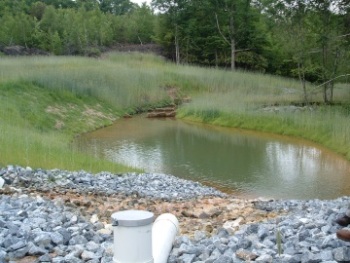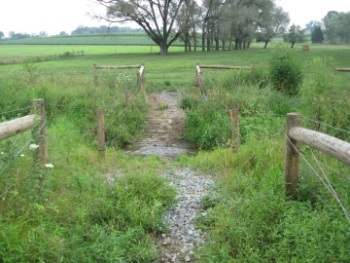On-the-ground Implementation
 |
 |
Stormwater Management
We can’t keep rain from falling, but we can manage it better once it does. PWD’s stormwater management program emphasizes the benefits of rain barrels, green roofs, and green streets. These vegetated features manage rain where it hits the ground similar to the way a natural system – such as a forest or meadow – would handle the rain runoff. This helps slow down and filter rainwater and improve water quality. PWD’s Source Water Protection Program and its partners have also been involved in the implementation of several types of best management practices (BMPs) throughout the watershed that have reduced water contamination from a variety of sources including stormwater runoff, agricultural runoff, and abandoned mine drainage (AMD).
Agriculture Best Management Practices
Agriculture runoff can introduce numerous contaminants into Philadelphia’s source waters, including nutrients, sediment and pathogens. OOW has been involved in the implementation of agriculture best management practices (BMPs) both within Philadelphia and over larger areas, including portions of the Schuylkill River watershed. Agriculture BMPs include stream bank fencing and stream crossings for livestock containment, manure storage units, and riparian buffers.
Storm Drain Markings and Waterway Signage
Philadelphia has an extensive storm-drain marking program that minimizes dumping of pet waste, toxins, and other pollution into storm drains and ultimately into our water supply.
In addition, when you bike down Kelly Drive and other hot spots bordering our waterways, you will soon notice sings pointing to “Philadelphia’s Drinking Water Source.” These signs will increase awareness and encourage responsible behavior towards highly traveled areas in Philadelphia that influence our water supply.
Parks for Waterways Protections
Fairmount Park was created over 100 years ago to safeguard the water supply – a role that the park continues to play today. Our partners at Fairmount Park were recently awarded $1.8 million in stimulus funds to support the natural lands in the Park system, strengthening the Park as a protective buffer and helping further efforts to safeguard Philadelphia’s drinking water.
Delaware Valley Early Warning System
The Delaware Valley Early Warning System (EWS), which has been fully operational since 2004, is an integrated monitoring, notification and communication system that provides water suppliers with advanced warning of water quality contamination events. The EWS is comprised of 4 principal components: the EWS partnership, the notification system, the monitoring network, and the web-based database and portal. The system has recently undergone several enhancements, which strengthen its power as a communication tool for various types of incidents, including sewage, oil, chemical, black fly spray, and flood/reservoir events. PWD is currently in the process of developing a Strategic Plan for the EWS. Through the planning process, PWD is evaluating the system’s core functions, user base, and potential funding sources to further enhance the system’s capabilities.
Rivercast
Rivercast is the first operable web-based recreational warning system in the United States. Using real-time flow, precipitation, and turbidity data, RiverCast predicts bacteria levels within a section of the Schuylkill River heavily used by the public for swimming, rowing and boating. RiverCast translates the predicted bacteria levels into one of three ratings, each of which corresponds to suggested guidelines for recreation. The site, which can be accessed at www.phillyrivercast.org, enables PWD to promote public awareness of water quality concerns and indirectly engages support for source water protection
Goose Management
In 2004, PWD planted a meadow in the area surrounding the Belmont water treatment plant intake on the Schuylkill River to deter geese. Prior to the project, as many as 100 geese would descend on this area, attracted by the long grass and food from picnickers. By deterring the geese, the meadow has reduced the impact of geese on the Belmont Plant intake and diverted more than 25 tons of goose manure annually.
PWD has also entered into a contract with the USDA’s Animal and Plant Health Inspection Services (APHIS) to implement an integrated waterfowl management program to reduce and prevent damages caused by Canadian geese at the Queen Lane and Baxter intakes.
Cryptosporidium Reduction
The Philadelphia Water Department is one of the nation’s leaders in addressing Cryptosporidium. By working closely with Philadelphia’s Department of Public Health, PWD can ensure that our tap water is free of pathogens that are found in rivers. In addition to performing routine monitoring for Cryptosporidium, PWD is involved in an innovative project with Lehigh University to identify the sources of Cryptosporidium in our watersheds using DNA analysis. Through this source tracking project, the department is taking a proactive approach to improving river water quality and reducing the risk of Cryptosporidium contamination.
The Philadelphia Water Department is also developing a Watershed Control Plan to submit under the EPA’s Long Term 2 Enhanced Surface Water Treatment Rule (LT2). The LT2 serves as a series of amendments too the Safe Drinking Water Act, and is the first drinking water regulation based on source water quality. The LT2 seeks to protect public health from illness due to Cryptosporidium and other microbial pathogens in drinking water and to address risk trade-offs with the control of disinfection byproducts. The watershed control plan is being developed for the Schuylkill River watershed, with the goal of providing an effective, watershed-wide approach to reducing Cryptosporidium in Philadelphia’s source waters.
Pharmaceuticals Reduction
 The water department has tested for pharmaceuticals in our raw and finished drinking water for over a decade. Attention to this issue has increased greatly, along with recent advances in technology to detect very low concentrations of trace contaminants in water. PWD has stayed at the forefront of this issue by participating voluntarily in national research studies and establishing analysis capabilities with advanced laboratories.
The water department has tested for pharmaceuticals in our raw and finished drinking water for over a decade. Attention to this issue has increased greatly, along with recent advances in technology to detect very low concentrations of trace contaminants in water. PWD has stayed at the forefront of this issue by participating voluntarily in national research studies and establishing analysis capabilities with advanced laboratories.
PWD’s source water protection program is continually looking for ways to reduce sources of pharmaceuticals in our waterways. The source water protection program is partnering with other organizations, specifically, the Women’s Health and Environmental Network, to evaluate the feasibility of take-back programs and other initiatives to reduce the amount of unused pharmaceuticals that reach the water supply.
For information on how to correctly dispose of pharmaceuticals, please see the following flyer. More information on this issue can also be viewed at: www.phila.gov/water/Pharmaceuticals_in_D.html.